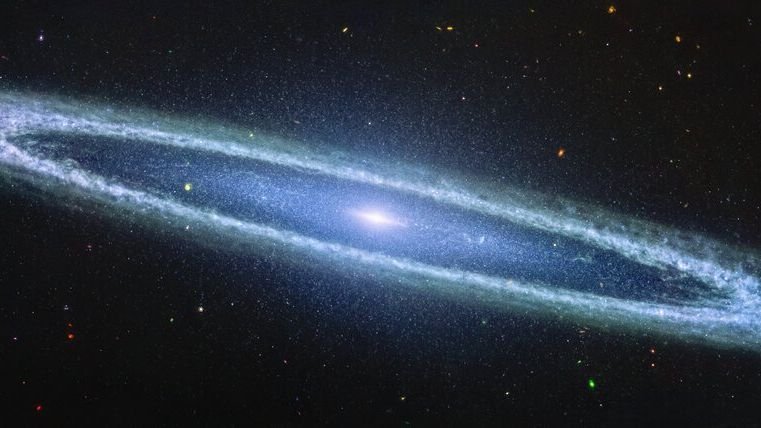The James Webb Space Telescope’s brand-new image of the Sombrero Galaxy casts this city of stars in a new light — mid-infrared light, to be precise — and reveals clumps of dust in a mottled outer ring.
The Sombrero galaxy is so named because, in visible light images, lying nearly edge-on to us, it bears an uncanny resemblance to a sombrero hat, with its wide rim and bulging center. In this new image taken by JWST‘s Mid-Infrared Instrument (MIRI), which can peer through clouds of gas and warm dust, those classic hallmarks of the Sombrero have vanished, replaced by a lumpy ring of dust around a gap that houses the bright core where a supermassive black hole lurks.
Located about 31 million light-years away in the constellation Virgo, the Sombrero (catalogued as Messier 104 and NGC 4594) is the most massive spiral galaxy within 100 million light-years of us. The total mass of all the Sombrero’s stars amounts to 260 billion solar masses, nearly five times greater than all the stars in our Milky Way galaxy.
You might therefore think that the Sombrero must be a hotbed of star formation, but it’s quite the opposite. On average, within the Sombrero, half a solar mass of gas is converted into stars per year, compared to the one to two solar masses in the Milky Way. In other words, it forms stars up to four times more slowly than our galaxy does.
Related: Facts about the Sombrero galaxy
Stars produce dust when they die, and that dust then clumps together, often around the nucleating sites of new stars being born. MIRI is able to cut through the visible glow of all the stars in the Sombrero and detect this cold dust. That’s why the Sombrero’s familiar bulge has all but vanished in this new image.
What MIRI sees is the Sombrero’s dust-rich outer ring, containing fascinating detail of wispy clouds of dust. In particular, MIRI observed the emission of polycyclic aromatic hydrocarbons (PAHs), which are large carbon-bearing molecules commonly found in star-forming regions. More than dust, however, what one needs to form stars is molecular hydrogen gas. The dust can insulate the gas, keeping it cold enough to undergo gravitational collapse.
Yet the star-formation rate tells us that there’s not much molecular hydrogen left in the Sombrero. Astronomers’ models imply that the large bulge seen in visible light probably formed during a huge starburst event many billions of years ago that used up most of the raw materials needed for stars. What gas remained has been fueling the meager rate of star formation ever since. This star formation takes place mostly in the dusty outer ring.
Despite lying in the general direction in our sky of the Virgo cluster of galaxies, the Sombrero is not a member of that cluster — it’s about 25 million light years closer to us, in a fairly empty region of space. Unlike our Milky Way, which has the Magellanic Clouds plus the Andromeda and Triangulum galaxies for company, the Sombrero is pretty isolated, a loneliness that had implications for its development that astronomers are still investigating.
Close encounters between galaxies can stir up gas and dust, shoving it toward the supermassive black hole at the center of those galaxies. When this happens, the black holes messily consume the material falling onto them, and the immediate environment around them lights up to become an active galactic nucleus (AGN), spitting out jets of high-energy particles that often move at close to the speed of light. It does not seem that the Sombrero has experienced such close encounters, at least not for many billions of years.
As such, the Sombrero’s approximately billion-solar-mass central black hole is pretty quiet these days, but we know that once upon a time it wasn’t. Earlier in 2024, astronomers using the Very Large Array of radio telescopes in New Mexico discovered huge lobes of radio wave-emitting particles stretching for about 30,000 light-years on either side of the Sombrero. These lobes had been produced by powerful jets that once blasted out from the Sombrero’s AGN. Even though there are no neighboring galaxies for the Sombrero to interact with and drive its AGN activity, it is possible a giant intergalactic cloud of gas fell onto the galaxy at some time in the past, providing the fuel for the AGN.
Today, the Sombrero’s black hole is so inactive that it produces a jet barely a few light-years long, as detected by the Very Long Baseline Array of radio telescopes across the United States.
With all this star formation and black hole activity of the past, it seems we’re late joining the Sombrero party and have missed all the excitement. Instead, we capture the scene of the day after, the party now a memory, the aftermath barely evident now that the dust has settled. Sat lonely in deep space, relatively safe from collisions with other galaxies, its partying days over, the Sombrero can now grow old gracefully.
Source link
